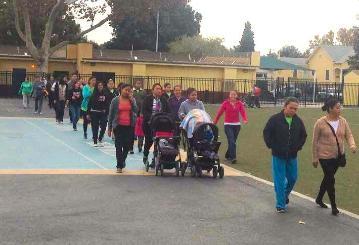The Greater Washington Neighborhood is home to a community of many brilliant, strong, resilient, and beautiful people. Most are immigrants who risked their lives coming to a land that they believed would allow them to support their children’s educational dreams. Often those dreams consist of being the first generation to attend college, graduate, get a good job, and have the opportunity to give back to family and community. At the same time, many families in the neighborhood live close to the Federal Poverty Line. They struggle to make ends meet while navigating a complicated social safety net that all too often closes more doors than it opens for them. Parents work hard to help their children resist gang influences, stay in school, and change the statistics that project they will fall behind on California’s state educational tests.
EDUCATIONAL ATTAINMENT
Washington Elementary, located in the Washington neighborhood is 94% Hispanic and Latino. In the 2010 academic year, only 56% of students scored proficient in English Language Arts, and 51% scored proficient in Mathematics on the California Department of Education’s Standardized Test. Current trends indicate that due to this academic lag, a quarter of these students will drop out of high school, and less than a quarter will take the required academic courses to be accepted into a four-year accredited university.*
BUSINESS
Since 2005, the number of Silicon Valley’s foreign-born residents who have founded new companies has taken a significant dip, from 52.4% to 43.9%.
HEALTH
In 2009, more than 27% of Latino children in the Silicon Valley were overweight. Proactive energy toward issues such as obesity, diabetes, and heart disease can be costly. It can also greatly affect a child’s ability to learn, develop strong self-esteem, and reach his or her full potential.
CITIZENSHIP
41% of Latinos in the Silicon Valley are foreign born, and of those, 72% were not US citizens in 2009. Without support systems that help navigate the pathway to citizenship, the experience can be daunting and confusing, and can cause major stress on families.

CULTURAL
The Latino culture places high value on a collective contribution to household income. A concentrated commitment can put pressure on youth, making attending a four-year university after high school seem like an impossible goal.
GEOGRAPHIC
The five neighborhoods shown on the map above are landlocked between two freeways and a railroad track, restricting access to neighboring resources. Resources, like those on the SCU campus or neighboring middle and upper class communities, are scarce in this area of San Jose.
LINGUISTIC
83% of students at Washington Elementary are English Language Learners. The majority of families who reside in these five neighborhoods do not speak fluent English. These language barriers make it difficult to connect with educational and community resources.
*Hispanic Foundation of Silicon Valley, (2011). Silicon Valley Latino Report Card.
